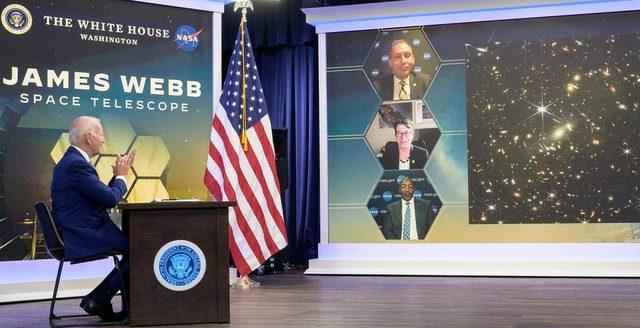The first full color photograph of the James Webb Space Telescope has been published.
The photograph, which includes galaxies billions of light years away from Earth, is the deepest and most detailed photograph of the universe ever taken.
The full color photos taken by the telescope will be released by NASA later today, but the first photo was shown to Biden during a briefing to President Joe Biden at the White House. It was later shared on the internet.
After sharing the image, Biden said, “These photos will remind the whole world that America can achieve great things. It will remind the American people, and especially our children, that nothing is beyond our capacity.”
“We can see possibilities that no one has seen before; we can go where no one has gone before.”
The $10 billion James Webb Space Telescope (JWST) was launched into space on December 25, 2021; It was said that it would replace the famous Hubble Space Telescope.
The telescope, which is planned to make various studies in space, also has two important goals: One is to photograph the first known stars of the Universe 13.5 billion years ago; The other is to look at whether planets very far from Earth are habitable.
The photo shared with Biden and then with the public; It showed that James Webb was able to achieve his first goal.
Seen in the photo is actually an area of the Southern Hemisphere showing the Volans constellation, where multiple galaxies gather. The name given here is SMACS 0723.
The galaxy community is actually not far from Earth; only 4.6 billion light years away. However, where these many galaxies come together, the lights of objects that are much, much farther away can be seen magnified.
This is possible with the ‘gravity effect’, which is the astronomical equivalent of the zoom lens in space telescopes.
With its 6.5-metre golden mirror and super-sensitive infrared instruments, Webb was also able to photograph the distorted shapes of galaxies that existed until about 600 million years after the Big Bang. (The Universe is known to be 13.8 billion years old)
More importantly; By looking at the quality of the data Webb obtained, scientists say that the telescope can actually see much further than the objects seen in this photo.
In other words, it is possible to say that this photograph is the deepest Universe photograph ever taken.
NASA’s Bill Nelson explained, “Light travels at 186,000 miles per second. And one of those little specks of light you see has been traveling for 13 billion years.”
“We actually go much further back because this is just the first photo. It can go back as far as 13.5 billion years. Now that we know the Universe is 13.8 billion years old, these photos take you back to almost the beginning of it all.”
Hubble had tried to achieve a similar result by staying in space for weeks. Webb, on the other hand, only took 12 and a half hours of observation to obtain images of objects at this depth.
Later Tuesday, NASA and its international partners, the Canadian and European Space Agencies, will also share other colorful images from Webb.
Thus, more detailed information can be obtained about planets outside the Solar System.
Webb also analyzed WASP-96 b, a giant planet about 1,000 light-years from Earth. The information to be shared will give us an idea about the atmosphere of this planet.
WASP-96 b orbits the star, its life-giving light, very, very closely. It is hoped that one day Webb will detect a planet with an atmosphere that is farther from the planet that is the source of life, just like Earth, and has an atmosphere that can be a source of life for humans.
Scientists at NASA believe Webb can certainly achieve his goals.
Commenting on the images that have not yet been shared with the public, Dr. “I saw the first photos, they’re amazing,” said Amber Straughn:
“They’re just gorgeous in appearance. I’m very excited to see what we can do with the clues hidden behind the details of science.”
One of the scientists working in the program of the Webb project, Dr. Eric Smith thinks the public already understands the importance of the new telescope:
“Webb’s design and appearance are what I think are the main reasons why the public is so enamored with this mission. It looks like a spaceship from the future.”
